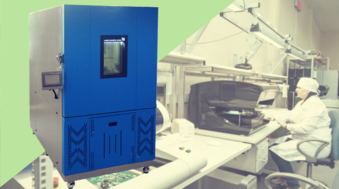
In the fast-evolving tech world, where every millisecond of performance matters, ensuring the longevity and reliability of electronic components is crucial. Often overlooked in the pursuit of innovation is Environmental Stress Screening (ESS), a process that plays a key role in guaranteeing the functionality and durability of components.
This blog will explore the transformative benefits of ESS, including reducing failures, improving quality control, and protecting your investments. By embracing ESS, manufacturers can stay ahead of the competition and ensure their products remain reliable and resilient in the face of real-world challenges.
Understanding the Importance of ESS for Electronic Components
Recognizing the significance of Environmental Stress Screening (ESS) for electronic components is essential in today’s competitive landscape. Electronic devices must not only function but also endure various environmental challenges throughout their lifecycle.
With the rapid pace of technological advancements, consumer expectations are higher than ever, demanding products that perform reliably under extreme temperatures, humidity, and vibration. Failing to meet these demands can result in product failures and damage to a brand’s reputation.
ESS is critical for identifying potential weaknesses early in the production process. Manufacturers can pinpoint issues before the product reaches the market. This proactive strategy minimizes field failure risks, ensuring that only durable components make it to consumers.
Ultimately, adopting ESS emphasizes quality over quantity—an important strategy for manufacturers seeking long-term success in an ever-changing industry.
How ESS Works: The Process and Techniques Used
Environmental Stress Screening (ESS) is a crucial process used to identify potential weaknesses in electronic components by simulating real-world environmental conditions. The goal is to detect and address flaws early in the production cycle, improving the overall reliability and durability of the product. The key techniques used in ESS include:
- Thermal Cycling: In this process, components are exposed to extreme temperature variations, mimicking the thermal stresses they might experience during their operational life. The rapid shifts between hot and cold conditions can reveal latent defects, such as solder joint failures or thermal expansion issues, that might not be visible under normal operating conditions.
- Vibration Testing: Components undergo simulated operational vibrations to test their resilience against mechanical stresses. This is particularly important for devices that will be used in environments with constant or frequent movement, such as in automotive or aerospace applications. Vibration testing helps ensure that components can withstand the forces they will encounter without degrading or failing.
- Humidity and Moisture Exposure: Components are exposed to high humidity or moisture conditions to evaluate their resistance to corrosion, short-circuiting, or other damage caused by environmental factors. This test is essential for ensuring that components maintain their functionality and longevity in humid or wet environments, which is particularly important for consumer electronics, outdoor devices, or automotive systems.
These techniques are integral to ensuring that electronic products meet the rigorous demands of real-world use and are capable of performing reliably throughout their lifespan.
The Benefits of ESS for Electronic Components
Environmental Stress Screening (ESS) offers numerous advantages for electronic components by subjecting them to various stress conditions, allowing manufacturers to identify potential weaknesses before products reach the market.
1. Improved Reliability and Durability
ESS plays a key role in enhancing the reliability of components by detecting potential failures early in the production process. Components that withstand ESS testing are more likely to perform reliably under real-world conditions, reducing the risk of malfunctions during the product’s lifecycle. ESS also improves durability, reducing the need for frequent replacements and promoting sustainability by producing longer-lasting products. This leads to increased trust and confidence among customers strengthening brand reputation and setting manufacturers apart in a competitive market.
2. Reduction in Costly Returns and Repairs
By catching defects early, ESS significantly reduces costly returns and repairs. Identifying and addressing weaknesses during production prevents performance issues from affecting consumers, ultimately lowering operational costs such as shipping, restocking, and labor. Additionally, fewer repairs ease the strain on service centers, allowing resources to focus on genuine customer needs. The reduction in unnecessary repairs and returns leads to more efficient product management and a healthier bottom line for manufacturers.
3. Increased Customer Satisfaction and Trust
ESS fosters higher customer satisfaction by ensuring products meet high-performance standards. Reliable and durable components generate confidence among consumers leading to increased brand loyalty. Fewer failures and a more dependable product experience reduce customer frustration and encourage positive word-of-mouth recommendations. The commitment to quality through ESS demonstrates a manufacturer’s dedication to safety and excellence, further solidifying trust and fostering long-term customer relationships.
Implementing ESS in Your Production Process
Integrating Environmental Stress Screening (ESS) into your production process can be smooth and effective with the right approach. Here are the key steps for successful implementation:
- Start Small: Begin by testing a specific line of electronic components. This focused approach ensures a manageable adoption process and smooth integration without overwhelming the system.
- Invest in the Right Equipment: Choose ESS equipment tailored to your products’ needs, such as thermal cycling chambers, vibration tables, and humidity chambers. The right tools simulate real-world stress conditions, ensuring accurate and reliable results.
- Train Your Staff: Proper training is essential. Educate your team on the ESS process and its importance in product reliability. Knowledgeable staff can identify issues early, improving product quality and reducing failures.
- Establish Clear Protocols for Analyzing Results: Create clear guidelines for analyzing ESS results. This systematic approach allows you to address any weaknesses identified, and continuous feedback loops will refine your testing methods over time.
By following these steps, manufacturers can successfully integrate ESS into their production, enhancing product durability, reliability, and overall customer satisfaction.
Common Misconceptions about ESS
- Only High-End Products Need ESS: A common misconception is that Environmental Stress Screening (ESS) is only beneficial for high-end products. In reality, even standard components can experience environmental stress that affects their performance. ESS helps identify weaknesses early, improving reliability for all product types.
- ESS Adds Too Much Time to Production: Some believe that ESS significantly slows down the manufacturing process. However, when integrated correctly, ESS can streamline testing by catching potential issues early, ultimately reducing delays and improving efficiency.
- ESS Is Expensive and Not Cost-Effective: Another myth is that ESS is too costly to justify its implementation. While there is an upfront investment, ESS can save manufacturers substantial amounts by preventing failures and costly repairs or returns later in the product lifecycle.
- ESS Guarantees No Defects: While ESS enhances product reliability, it is not a foolproof solution. No testing method can guarantee that defects will never occur. ESS increases the likelihood of detecting weaknesses early but it cannot provide absolute assurance against failure.
- ESS Requires Major Changes to Production Lines: Many manufacturers assume that implementing ESS will require significant alterations to their production lines. However, modern testing systems can often be integrated seamlessly into existing workflows, avoiding major disruptions to production processes.
Conclusion: Why ESS is a Must-Have for Electronic Component Manufacturers
Environmental Stress Screening (ESS) provides significant benefits for electronic component manufacturers by detecting potential weaknesses before products hit the market. This proactive approach improves reliability and durability.
The financial savings from fewer defects contribute to greater profitability and heightened customer satisfaction and trust. Manufacturers who adopt ESS demonstrate a commitment to quality, gaining a competitive advantage in the market.
In today’s rapidly evolving tech landscape, implementing ESS is becoming essential. The long-term advantages in product performance and brand reputation far outweigh any initial costs or adjustments in production, making it a smart investment for future success.







